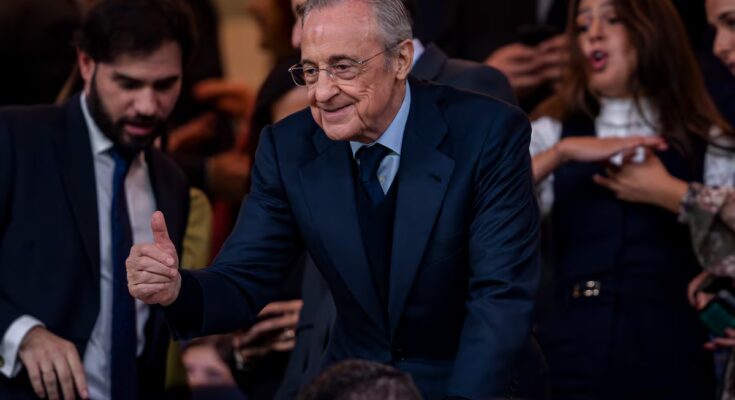Real Madrid president Florentino Pérez continues to outline the club’s corporate reorganization proposal, which he is expected to present at the ordinary annual meeting of representative members on November 23. The latest formula used would allow the entry of an investor partner with a share of between 5% and 10% of the capital of the new company and would leave the remaining 95% or 90% in the hands of the partners, according to sources close to the model project to become a SAD.
The idea is that the entry of this investor serves, in addition to raising liquidity, as a sort of evaluation that establishes the value of the entity. At last year’s meeting, Pérez provided his estimate: “We have to distribute an asset which, I don’t want to exaggerate, they say is worth 7,000, but which I believe is worth more than 10,000 million euros.” An investor willing to pay 1,000 million for 10% of the club would confirm this calculation.
The price paid by the Apollo fund in exchange for 57% of Atlético de Madrid, for example, gave a valuation of the red and white club of 2.5 billion. In France, when the Arctos fund purchased 12.5% of Paris Saint-Germain for just over 500 million, it valued the club at 4.25 billion. In January this year the Los Angeles Lakers NBA team was sold for 8.7 billion euros.
Pérez prefers to limit the entry of a partner to 10%, as well as requiring that the investor who buys that first package cannot buy another if the partners decide to sell other packages in the future.
The remaining 90% would be distributed in shares of equal value among the approximately 100,000 shareholders in Madrid. Each shareholder would also see their presence in the capital limited to a single shareholding. These shares could be sold, but only to another member who does not already own them, for example to new members, who can only be admitted if they are children or grandchildren of other members. This distribution of shares and the limitations on their transmission are aimed at preserving the current governance nature of the club.
Pérez outlined the general lines at the last meeting: “A proposal for the corporate reorganization of the club that clearly secures our future, protects us from the threats we suffer and, above all, guarantees that the members are true owners of our club, true owners of our economic assets and with full rights. And, of course, introducing the necessary elements so that the effective control of the club always remains in the hands of its members.” Furthermore, he promised to hold a referendum to submit his proposal to the consideration of all members, as established in the statute.
The process for Madrid to reach its new form is long and complex. It doesn’t actually even start at the assembly in ten days. When the club announced the convening of this annual meeting on November 5, it did so with a significant change from previous years. Unlike what was customary, he did not call the ordinary and extraordinary meetings for the same day, but only the first. The topic of transformation does not appear expressly on the agenda, although Pérez should address it in the first point, the “president’s report”, in which he already explained the reasons for his idea last year. Consider that during the drafting of the last sports law in 2022 they were about to be deprived of some of their economic rights, which was only avoided by a rare agreement between the PSOE and the PP to amend the text. The procedure for the modification is established by article 58 of the statute, approved in 2012: “Its transformation, merger or extinction may proceed only if so agreed by the absolute majority of members with the right to vote in a referendum called for this purpose by the Extraordinary General Assembly”.
The first step is to hold an extraordinary meeting, the date of which has not yet been set, in which the representative partners will approve the holding of a referendum on the president’s concrete proposal. The conditions for its approval are very strict. The “absolute majority of members entitled to vote” means that it should obtain more than 50,000 yes votes. It would not be enough if the vote was successful and the sum of the positive votes did not reach half plus one of the total number of those entitled to vote, those of age with more than one year of service.
A long process
The last time Real Madrid members went to the polls was in the 2006 presidential elections, won by Ramón Calderón with 8,344 votes, 246 more than Juan Miguel Villar Mir. 27,102 people voted in person that day and about 10,000 did so by mail, but the courts invalidated those votes.
If the referendum were in favor of the change, the procedure for transformation into a sports limited company would be opened, regulated in Royal Decree 1251/1999 and in the transitional provisions of Royal Decree 1084/1991. The procedures begin with a request to the Joint Transformation Commission, which regulates the process. This commission is made up of nine members: a president appointed by the Superior Sports Council, three members appointed by the CSD, three members appointed by LaLiga, one member appointed by the CSD on the proposal of the Royal Spanish Football Federation and one member appointed by the CSD on the proposal of the most representative association of professional athletes.
This commission has the task of drawing up a report on the share capital proposed by the club, which according to the lines of the latest proposal drawn up by Florentino Pérez will be derived from the price paid by the chosen investor for that package between 5% and 10% that he intends to put up for sale. According to CSD sources, the commission will only be able to object if the proposed capital implies that the company is subject to dissolution. This can be avoided with a capital equal to at least double your negative net worth of at least 60,000 euros. From that moment on you will have a maximum of nine months to assign all the shares.



